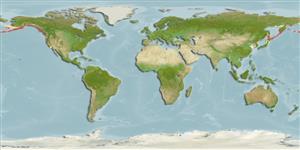Preferred temperature (Ref.
115969): 4.1 - 13, mean 8.6 (based on 128 cells).
Phylogenetic diversity index (Ref.
82804): PD
50 = 0.5159 [Uniqueness, from 0.5 = low to 2.0 = high].
Bayesian length-weight: a=0.00832 (0.00361 - 0.01917), b=3.12 (2.92 - 3.32), in cm Total Length, based on LWR estimates for this (Sub)family-body shape (Ref.
93245).
Trophic level (Ref.
69278): 3.6 ±0.55 se; based on food items.
Widerstandsfähigkeit (Ref.
120179): mittel, Verdopplung der Population dauert 1,4 - 4,4 Jahre. (tm=3-5; tmax=18).
Prior r = 0.23, 95% CL = 0.15 - 0.35, Based on 1 full stock assessment.
Fishing Vulnerability (Ref.
59153): Moderate vulnerability (44 of 100).
